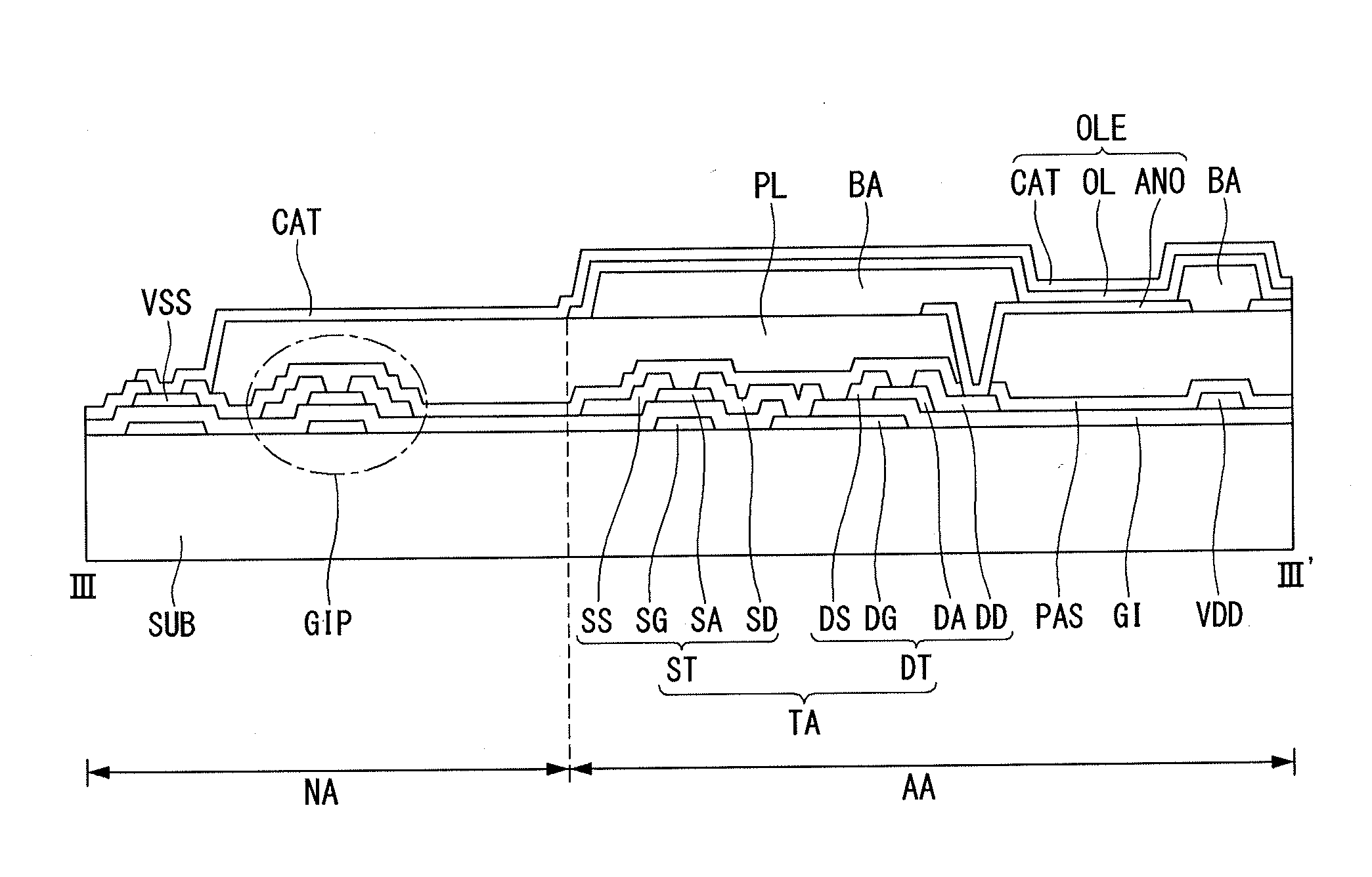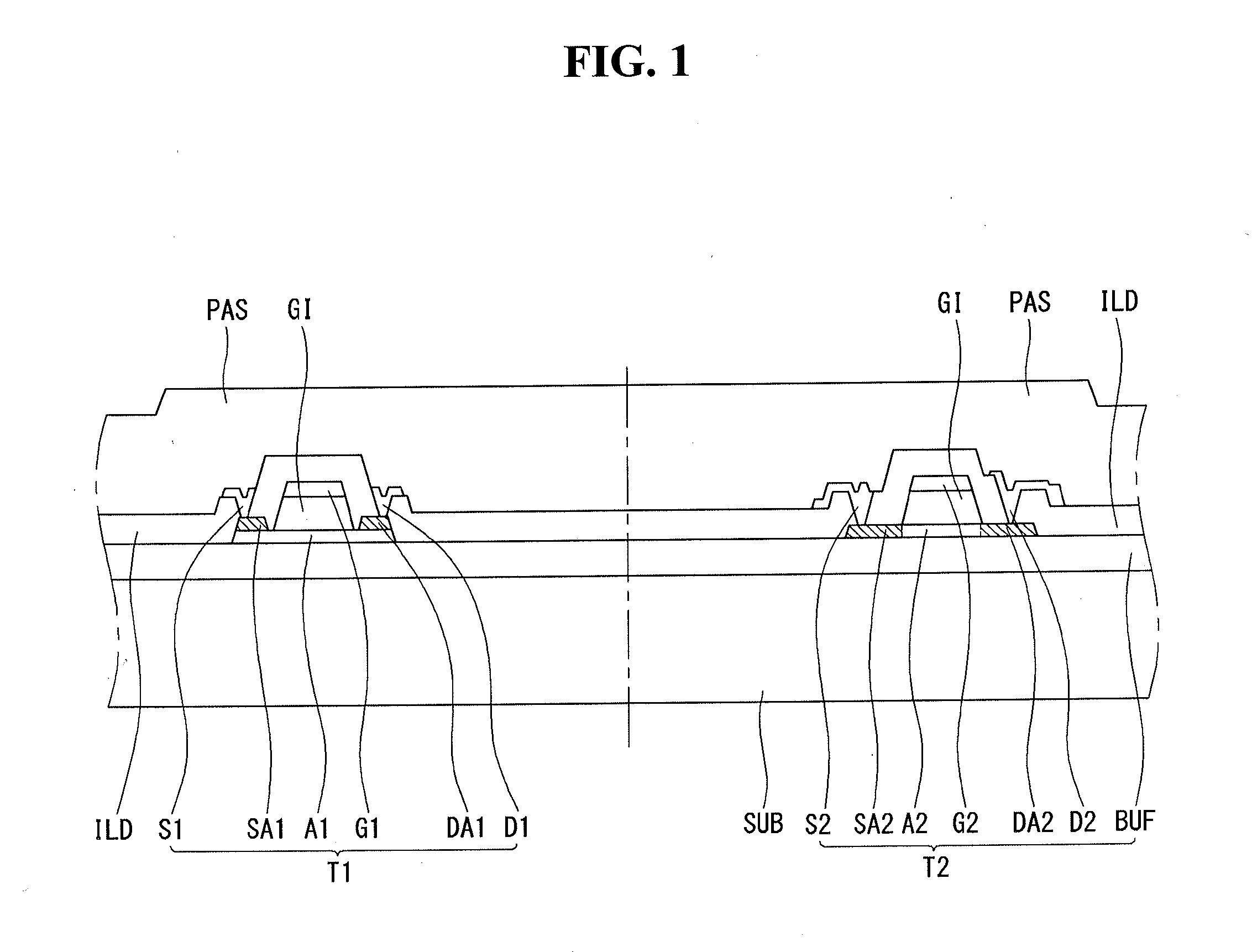Thin film transistor substrate and display using the same
a technology of thin film transistors and substrates, applied in static indicating devices, instruments, thermoelectric devices, etc., can solve problems such as limit on power consumption reduction, and achieve the effects of low power consumption, low off-current characteristics, and low frequency driving properties
- Summary
- Abstract
- Description
- Claims
- Application Information
AI Technical Summary
Benefits of technology
Problems solved by technology
Method used
Image
Examples
first example embodiment
[0041]The first example embodiment of the present invention is discussed with reference to FIG. 1. FIG. 1 is a cross sectional view illustrating a structure of a thin film transistor substrate for a flat panel display in which two different types of thin film transistors are formed, according to the first example embodiment of the present invention. Here, the cross sectional views are more often referenced mainly because they more clearly show features of the example embodiments of the present invention than plane views.
[0042]As shown in FIG. 1, the thin film transistor substrate for a flat panel display according to the first example embodiment comprises a first thin film transistor T1 and a second thin film transistor T2, which are disposed on the same base substrate SUB. The base substrate SUB may hereinafter be referred to as the substrate SUB or the substrate. The first and second thin film transistors T1 and T2 may be disposed substantially far apart from each other, or they m...
second example embodiment
[0063]The second example embodiment of the present invention is discussed herebelow with reference to FIG. 3. FIG. 3 is a cross sectional view illustrating a structure of a thin film transistor substrate for a flat panel display in which two different types of thin film transistors are formed, according to the second example embodiment of the present invention.
[0064]In the first example embodiment, on the both side portions of the channel area in the polycrystalline semiconductor layer, the oxide semiconductor layer is formed and treated to become conductive to define the channel area. That is, the polycrystalline semiconductor layer does not have a doped area. Therefore, in some cases, there may be a potential issue of a relatively high resistance at the connection between the polycrystalline semiconductor layer and the source or drain electrode as it may lack an ohmic contact.
[0065]The second example embodiment provides a structure of the thin film transistor substrate having two ...
third example embodiment
[0092]Hereinafter, the third example embodiment of the present invention is discussed with reference to FIG. 5. FIG. 5 is a cross sectional view illustrating a structure of a thin film transistor substrate for a flat panel display in which two different types of thin film transistors are formed, according to the third example embodiment of the present invention.
[0093]With respect to the features of the structure and the manufacturing process, the third example embodiment is very similar to the first example embodiment. The differences may include how a channel area is defined. For example, the channel area may be defined by a process to make the channel area conductive in the first example embodiment, whereas the channel area may be defined by a doping process in the third example embodiment. The third example embodiment may be more suitable for manufacturing the two different types of thin film transistors that are directly and / or serially connected to each other on the same substr...
PUM
 Login to View More
Login to View More Abstract
Description
Claims
Application Information
 Login to View More
Login to View More - R&D
- Intellectual Property
- Life Sciences
- Materials
- Tech Scout
- Unparalleled Data Quality
- Higher Quality Content
- 60% Fewer Hallucinations
Browse by: Latest US Patents, China's latest patents, Technical Efficacy Thesaurus, Application Domain, Technology Topic, Popular Technical Reports.
© 2025 PatSnap. All rights reserved.Legal|Privacy policy|Modern Slavery Act Transparency Statement|Sitemap|About US| Contact US: help@patsnap.com



